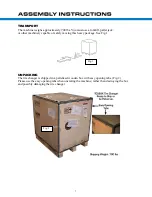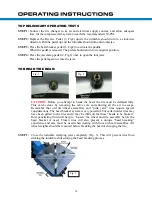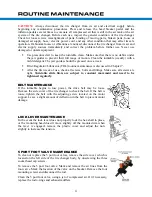
19
TO INFLATE THE TIRE:
CAUTION:
An over inflated tire can fail, causing serious injury or even death to the
operator. Always make sure the wheel and the tire are of the same size. Check the
condition of the tire, and make sure it has no defects before beginning the inflation
process. Keep your hands and body as far away from the tire as possible. Inflate the
tire with brief jets of air, checking the air pressure frequently.
Never inflate a tire above and or below the air pressure recommended by the tire
manufacturer.
STEP 1:
To inflate the tire, attach the air hose nozzle to the tire valve stem with the locking
lever in the “UP” position. Check the condition of the tire, and make sure the nozzle
is pressed down completely over the threads of the valve stem (Fig. 19).
STEP 2:
When the air gauge nozzle is firmly in place, press the locking lever down to lock
onto the valve stem.
Remember to inflate the tire with brief jets of air, checking the air pressure frequently.
Once the proper air pressure has been reached on the gauge, disconnect the nozzle
from the valve stem and screw a valve core into the stem (Use caution when inserting
the valve core, air will blow out of the stem when the nozzle is removed). Re-attach
the nozzle and adjust the air pressure as needed.
NOTES:
Failure to follow all warnings and instructions may lead to serious personal injury or death to the
operator or a bystander.
NEVER
exceed 50psi (3.5 bar) when seating beads or inflating tires.
If a higher tire inflation pressure is required, remove the wheel from the tire changer
and continue the inflation procedure with the wheel inside a special protection cage
(commercially available).
NEVER
exceed the maximum inflation pressure given by the tire manufacturer.
ALWAYS
keep hands and entire body back while inflating a tire.
ONLY
specially trained personnel should be allowed to perform these operations.
Fig. 19
































